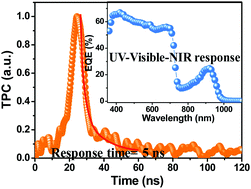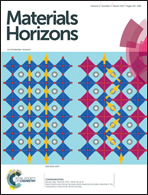Integration of perovskite and polymer photoactive layers to produce ultrafast response, ultraviolet-to-near-infrared, sensitive photodetectors†
Abstract
Low-cost organic photodetectors have shown sensitivity levels comparable to those of inorganic photodetectors, but with response speeds generally limited to the megahertz range due to the low mobility of organic semiconductors. Here, we integrated organic–inorganic hybrid perovskite (OIHP) photoactive layers with low-bandgap organic bulk-heterojunction (BHJ) layers to produce a device that combined the advantages of the two types of photodetectors. Integrating methylammonium lead triiodide (CH3NH3PbI3) with a low-bandgap BHJ layer extended the response of perovskite photodetectors to a wavelength of 1000 nanometers without deteriorating the responsivity and specific detectivity of either type of photodetector. The high mobility of charge carriers in CH3NH3PbI3 allowed the constraints of the resistance–capacitance constant to be relieved so that the device response speed could be increased dramatically. A response time of five nanoseconds was measured for incident infrared light from the device with an active area of 0.1 square millimeters, which represents the state-of-the-art performance for organic-based photodetectors.



 Please wait while we load your content...
Please wait while we load your content...